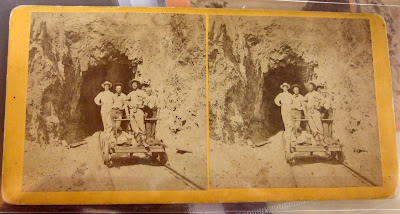University Archives
Remember when I mentioned great storytellers earlier? Well, Bob Parson, the USU University Archivist since 1995, is one. He showed me an amazing copy letter book of John T. Caine, Jr., the secretary of the school back at its humble beginnings in 1888. Caine's correspondence with the Board of Trustees and the school's first president, Jeremiah Wilson Sanborn, showed that he set up the school and found the people with the expertise to run it. Below is a photo of one copy book open to correspondence from 1909.
 |
| From Utah State University |
Bob showed me a letter from 1890 in which Caine tells a seal maker charged with forging the official school seal that he is dissatisfied with the quality of workmanship. There were no other records of the seal until 100 years later, when workmen excavating the flower bed of Caine's descendants' home found the original brass seal. They brought it to Bob who was able to identify it from the records in the University Archives.
Here is that legendary seal.
 |
| From Utah State University |
What is so remarkable about the USU University Archives is the completeness of the records. With the exception of presidents #2 and #3 (whose records may have burned in a fire in 1905), the school holds all the administrative papers from all the presidents. Bob has personally processed three presidents' records. Rose Ernstrom, the Executive Secretary to the president had a system that made it a pleasurable experience for Bob. He explains why below.
Photographs
Another USU staffer who loves his work is Daniel Davis, Photograph Curator. He manages the 500,000 photograph collection (150,000 have been processed and a much smaller portion has been digitized). One of his passions is stereo views related to the Transcontinental Railroads. Below is a short video of Daniel explaining why.
Below are a selection of close-ups of the stereo views in the video.
 |
| From Utah State University |
 |
| From Utah State University |
 |
| From Utah State University |
The photographer was A.J. Russell & Company, and the Utah photos were taken in 1868. As working documents, the stereo views documented the progress of the railroad in a way that a written report never could. Daniel is writing a book on the subject and has followed the whole route, photographing the same images. I can't wait to see his work as a published book!
Fife Folklore Archives
To wrap up my tour of the Utah State University Special Collections and University Archives, Brad introduced me to Randy Williams, Folklore Curator and 17-year veteran of USU's Special Collections. If you need to know anything about the folklore of the American West, the Fife Folklore Archives is the place to go. Austin E. and Alta S. Fife traveled the West with the intention of capturing on film, audio, and paper the folklife they encountered. They recorded cowboy and western songs, Mormon folksongs and stories, and lyrics read aloud. Essentially, they were oral historians with a knack for field work.
In the mid-1960s, the Fifes donated their extensive field work collections to the library, including acetate discs and reel-to-reel field recordings, 67 bound volumes of field notes/transcriptions, and their extensive folklore book collection. In 1972, the library created the Fife Library of Western Folklore, known today as the Fife Folklore Archives, and worked with the Fifes to create a folklore program at USU.
According to USU,
The Fife Folklore Archives collects field data, oral histories, monographs, slides, photographs, periodicals, books, audio recordings, and non-commercial video recordings on the subject of folklore, particularly but not exclusively in the areas of regional folklore (including the Intermountain West, especially Utah and Idaho); folk groups (including ranching culture, Native American culture, Latino culture, and Mormon culture); genres (including belief, folksongs, foodways, proverbs, and legends)and themes (including family, ethnic, and religious folklore). As well, the Archives maintains a basic folklore research and reference collection.
Below Randy shows me the card files created by the Fifes to organize and catalog their collection. "Alta Fife was a computer before there were computers," she says.
 |
| From Utah State University |
In 1984, the Fife Folklore Archives gained copies of 324 student field work projects (spanning 1968-1978) conducted by upper-level folklore students at BYU. The courses had been taught by Professor William A. Wilson, who became the first director of USU's Folklore Program and the Fife Folklore Archives. When he returned to Provo, he not only gave copies of the BYU students' work to USU, he did the same for his USU students and took those copies to BYU.
Today, the collections in the Fife Folklore Archives number 46 and include the Latino/Latina Voices Project, Peggy Seeger Folk Song Collection, John S. and Orpha S. Boyden Family Native American Book Collection, Cache Valley Presbyterian Church Oral History Collection, Skaggs Cowboy Poetry Collection, Grouse Creek (Utah) Cultural Survey, and many more. Of particular interest is the Fife Slide Collection of Western U.S. Vernacular Architecture, available at the USU Digital Library. Randy has prepared very detailed registers (think finding aids) that are well worth the scanning.
Conclusion
USU certainly has a lot to offer patrons and researchers in a wide range of areas. I hope I have inspired you to explore the collections both in person and online.
Contact Information
Interested users and donors should contact
Brad Cole
Associate Library Dean
Special Collections and Archives
Merrill-Cazier Library
Utah State University
3000 Old Main Hill
Logan, Utah 84322-3000
435-797-8268
Brad.Cole@usu.edu
http://library.usu.edu/specol/index.php
No comments:
Post a Comment